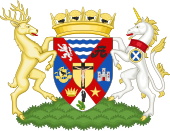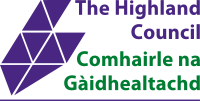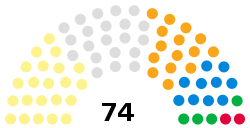The Highland Council
The Highland Council Comhairle na Gàidhealtachd | |
|---|---|
 Coat of Arms | |
 Council logo | |
| Type | |
| Type | |
| Leadership | |
Derek Brown since 22 June 2023 | |
| Structure | |
| Seats | 74 councillors |
 | |
Political groups |
|
Length of term | Full council elected every 5 years |
| Elections | |
| Single transferable vote | |
Last election | 5 May 2022 |
Next election | 6 May 2027 |
| Meeting place | |
 | |
| Council Headquarters, Glenurquhart Road, Inverness, IV3 5NX | |
| Website | |
| www | |
The Highland Council (Comhairle na Gàidhealtachd Scottish Gaelic pronunciation: [ˈkʰõ.ərˠʎə nə ˈkɛːəl̪ˠt̪əxk]), the political body covering the Highland local authority created in 1995, comprises 21 wards, each electing three or four councillors by the single transferable vote system, which creates a form of proportional representation.[2][3] The total number of councillors is 74,[3] and the main meeting place and main offices are at the Highland Council Headquarters in Glenurquhart Road, Inverness.[4]
Political control[edit]
The council has been under no overall control since 2007. Following the 2022 election the SNP formed the largest group with 22 councillors; this was the first time since the council's inception that independent councillors did not form the largest grouping. The SNP and some of the independent councillors subsequently formed a coalition to run the council.[5]
Composition[edit]
Following the 2022 election, subsequent changes of allegiance, and a by-election, the composition of the council is currently:[6]
| Party | Councillors | |
|---|---|---|
| SNP | 21 | |
| Independent | 23 (across two groups) | |
| Liberal Democrats | 14 | |
| Conservative | 8 | |
| Scottish Green | 4 | |
| Labour | 2 | |
| Alba | 1 | |
| Total | 74 | |
Of the independent councillors, 18 form the "Highland Independent" group which is in coalition with the SNP to form the council's administration. Five other independent councillors form the "Highland Alliance" group.
History[edit]
The first elections to the Highland Council were in 1995, when the unitary council was created under the Local Government etc. (Scotland) Act 1994. Since then, there have been general elections of the council at four year intervals. From 1999 to 2007 these elections coincided with general elections of the Scottish Parliament, but the 2012 council election was delayed by a year, until 2012, to end this coincidence. Since then elections have been held every five years, both at council and national level.
The new council was created to replace a regional council and eight district councils, which had been created under the Local Government (Scotland) Act 1973, and were abolished in 1996. Until 2007, the new council maintained decentralised management and committee structures which related to former district boundaries, except this arrangement was compromised by changes to ward boundaries in 1999, so that committees ceased to represent exactly the areas for which they were making decisions. New management and committee structures, involving three corporate management areas and related committees, were created at the same time as the introduction of multi-member wards and single transferable vote elections in 2007.
The 1995 election created a council of 72 members, each elected from a single-member ward by the first past the post system of election. Ward boundaries were redrawn for the 1999 election, to create 80 single-member wards and, again, election was by the first past the post system. The same wards and the same system of election were used for the 2003 election. For the 2007 election, ward boundaries were redrawn again, under the Local Governance (Scotland) Act 2004, to create the 22 multi-member wards, each electing three or four councillors by the single transferable vote system, but still electing a total of 80 councillors. For the 2017 election, the number of wards was reduced to 21, and the total number of councillors to 74. New ward boundaries were proposed by Boundaries Scotland in 2021 which would have reduced the total number of councillors to 73, however these were rejected by the Scottish Parliament.[7]
The eight older management areas, created when district councils were abolished in 1996, were also groups of wards, and each management area had an area committee of councillors elected from the wards in the area. Three of the older management areas, Caithness, Nairn and Sutherland, were very similar to earlier local government counties. Two others, Inverness and Ross and Cromarty, had the names of earlier counties but have very different boundaries.
In 2007, the then 22 wards were divided between three corporate management areas, and each of these was subdivided to create a total of 16 ward management areas.[8] Some wards are grouped into larger areas for ward management purposes, and one ward is divided between two different ward management areas. Therefore, the number of ward management areas is less than the number of wards.
The corporate management areas were named as (1) Caithness, Sutherland and Easter Ross, (2) Inverness, Nairn, and Badenoch and Strathspey, and (3) Ross, Skye and Lochaber. Two of these names are also those of Westminster Parliament (House of Commons) constituencies, and one name is very similar to the name of another Westminster constituency, but constituency and corporate management area boundaries are different.

Corporate management areas were represented, for some purposes, by their own committees. Also, there was an Inverness city management area covering seven of the nine wards (and thus four of the six ward management areas) of the Inverness, Nairn, and Badenoch and Strathspey corporate management area, with the city area being represented by a city committee.
The former management areas were:
| 1996 to 1999 | 1999 to 2007 | |
|---|---|---|
| Badenoch and Strathspey | consisting of 5 wards | with 5 related wards |
| Caithness | consisting of 8 wards | with 10 related wards |
| Inverness | consisting of 20 wards | with 23 related wards |
| Lochaber | consisting of 8 wards | with 8 related wards |
| Nairn | consisting of 5 wards | with 4 related wards |
| Ross and Cromarty | consisting of 13 wards | with 18 related wards |
| Skye and Lochalsh | consisting of 6 wards | with 6 related wards |
| Sutherland | consisting of 7 wards | with 6 related wards |
The numbers of wards in each corporate management area, and the number of councillors representing them, was as follows:
| Caithness, Sutherland and Easter Ross | 7 wards electing 23 councillors |
| Inverness, Nairn and Badenoch and Strathspey | 9 wards electing 34 councillors |
| Ross, Skye and Lochaber | 6 wards electing 23 councillors |
For lists of historic wards and details of how they were grouped into corporate and ward management areas, see:
- Highland Council wards 1995 to 1999
- Highland Council wards 1999 to 2007
- Highland Council wards created in 2007
Wards[edit]

As of 2017, there are 21 wards, each of which is represented by 3 or 4 councillors. Ward forums are held by the councillors representing each ward: these meetings are open to the public.[9] A Ward Manager is appointed to each ward or group of wards.[10] Each ward receives a small discretionary budget that is managed by the ward manager.[9]
The councillors representing groups of wards also sit as area committees, each covering areas which to some extent correspond with former local government boundaries. There are area committees for the counties of Caithness, Sutherland and Nairnshire, as well the city of Inverness. The remaining area committees cover Badenoch and Strathspey, the Black Isle, Dingwall and Seaforth, Easter Ross, Lochaber, the Isle of Skye and Raasay, and Wester Ross, Strathpeffer and Lochalsh.[11]
List of wards:
| Ward number | Ward | Seats |
|---|---|---|
| 1 | North, West and Central Sutherland | 3 |
| 2 | Thurso and North West Caithness | 4 |
| 3 | Wick and East Caithness | 4 |
| 4 | East Sutherland and Edderton | 3 |
| 5 | Wester Ross, Strathpeffer and Lochalsh | 4 |
| 6 | Cromarty Firth | 4 |
| 7 | Tain and Easter Ross | 3 |
| 8 | Dingwall and Seaforth | 4 |
| 9 | Black Isle | 3 |
| 10 | Eilean a' Cheò | 4 |
| 11 | Caol and Mallaig | 3 |
| 12 | Aird and Loch Ness | 4 |
| 13 | Inverness West | 3 |
| 14 | Inverness Central | 3 |
| 15 | Inverness Ness-side | 3 |
| 16 | Inverness Millburn | 3 |
| 17 | Culloden and Ardersier | 3 |
| 18 | Nairn and Cawdor | 4 |
| 19 | Inverness South | 4 |
| 20 | Badenoch and Strathspey | 4 |
| 21 | Fort William and Ardnamurchan | 4 |
References[edit]
- ^ Political representation The Highland Council
- ^ "The Highland (Electoral Arrangements) Order 2006". legislation.gov.uk. 2006. Retrieved 11 October 2015.
- ^ a b "Council wards". highland.gov.uk. Highland Council. Retrieved 11 October 2015.
- ^ Ordnance Survey grid reference for Highland Council Headquarters, Glenurquhart Road, Inverness: NH661448
- ^ "SNP-independent coalition control Highland Council". BBC News. 26 May 2022. Retrieved 16 July 2023.
- ^ "Councillors by Party". The Highland Council. Retrieved 3 December 2023.
- ^ "2019 Reviews of Electoral Arrangements". Boundaries Scotland. Retrieved 3 January 2022.
- ^ "Corporate Managers Appointed". Highland Council. 23 February 2007. Retrieved 17 August 2014.
- ^ a b "Council wards". The Highland Council. Retrieved 4 December 2018.
- ^ "Ward managers". The Highland Council. Retrieved 4 December 2018.
- ^ "Overview of committee membership and office bearers". The Highland Council. Retrieved 4 December 2018.
External links[edit]
- Official website
- "Independents in talks on joint election campaign". The Scotsman. 9 September 2006. Retrieved 11 October 2015.
